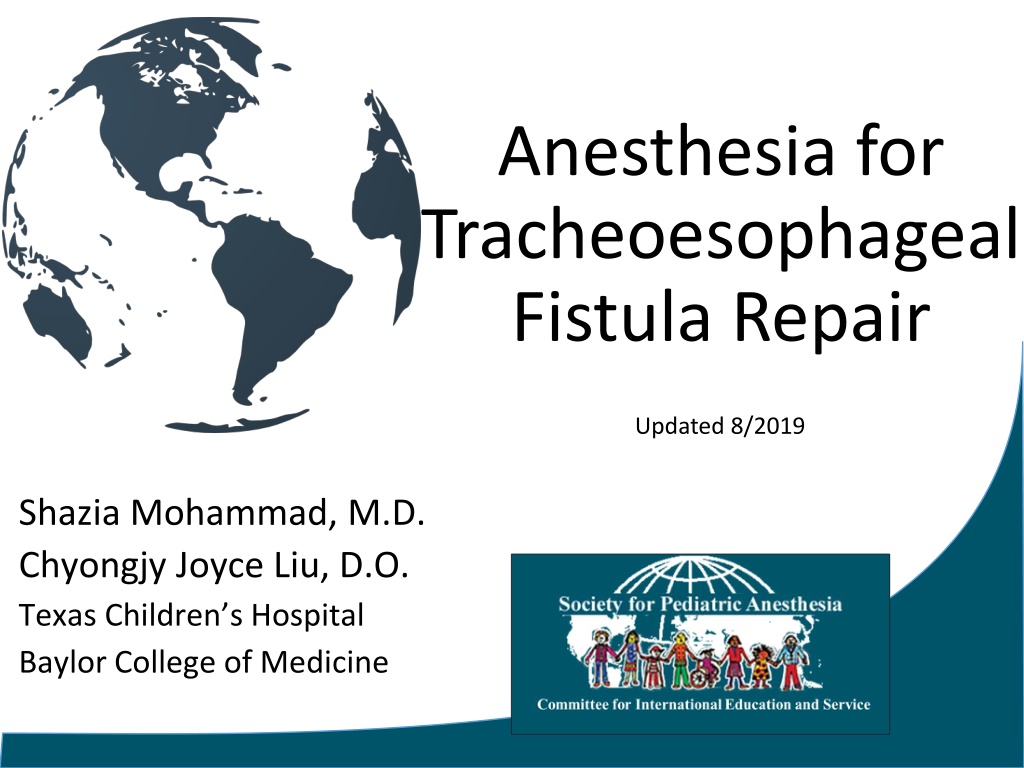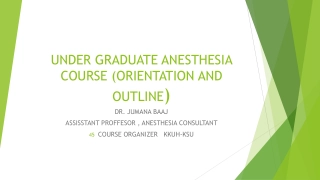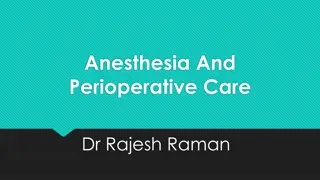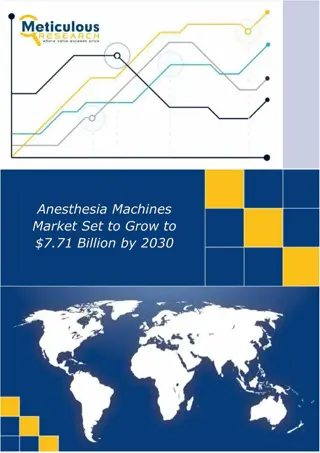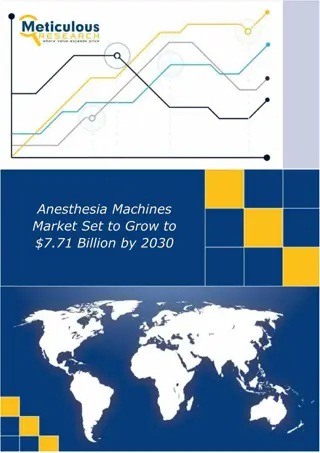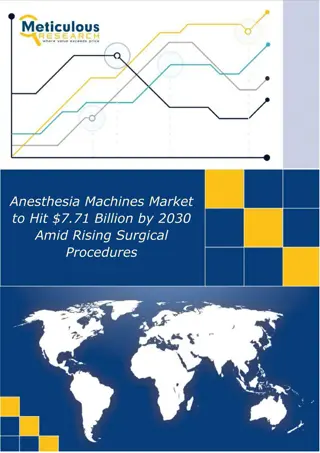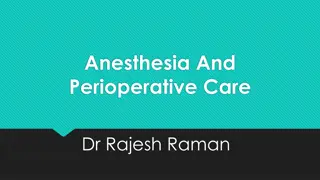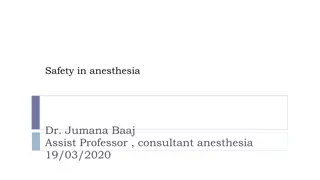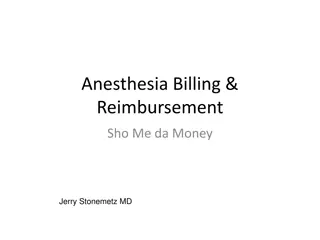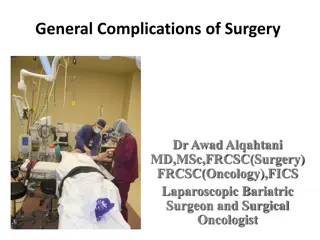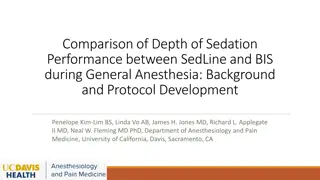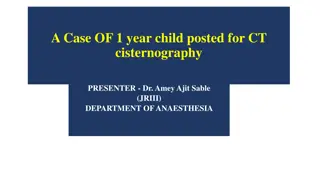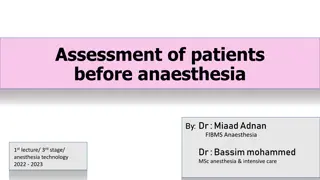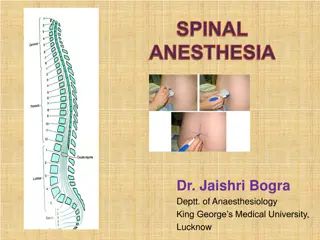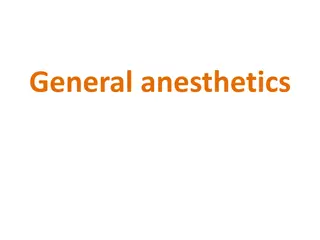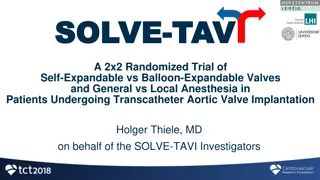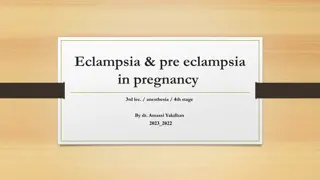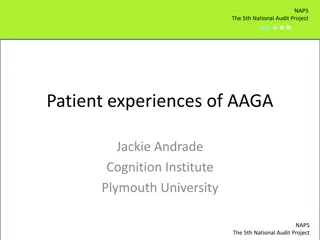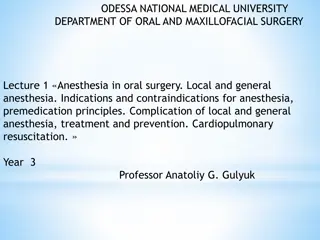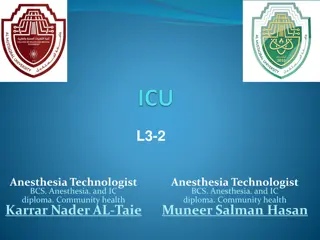Anesthesia Considerations for Tracheoesophageal Fistula Repair
Tracheoesophageal fistula (TEF) is a rare abnormal connection between the esophagus and trachea, often associated with congenital anomalies. This article covers TEF clinical presentation, prevalence, diagnosis, management, and anesthesia considerations. Understanding TEF and its related syndromes is essential for healthcare professionals involved in the care of affected patients.
Download Presentation

Please find below an Image/Link to download the presentation.
The content on the website is provided AS IS for your information and personal use only. It may not be sold, licensed, or shared on other websites without obtaining consent from the author. Download presentation by click this link. If you encounter any issues during the download, it is possible that the publisher has removed the file from their server.
E N D
Presentation Transcript
Anesthesia for Tracheoesophageal Fistula Repair Updated 8/2019 Shazia Mohammad, M.D. Chyongjy Joyce Liu, D.O. Texas Children s Hospital Baylor College of Medicine
Disclosures No relevant financial relationships
Learning Objectives: Review the clinical presentation of a patient with tracheoesophageal fistula (TEF) Understand the prevalence of TEF, types, and associated syndrome Discuss the diagnosis of TEF Describe the medical and surgical management of TEF Understand the anesthetic-related implications and develop an anesthetic plan
Clinical Scenario 1-day-old male with PMH significant for excessive secretions despite suctioning, recurrent coughing, and choking with episodes of cyanosis Symptoms worsen with feeding
Background Tracheoesophageal fistula (TEF) abnormal connection between the upper gastrointestinal tract and respiratory tract Occurs sporadically in 1/3000 live births5 No preference between sex or race5 20-40% of infants with TEF are born premature and/or small for gestational age7
TEF Associated Syndrome Associated with other congenital anomalies in 25-50% patients 25-35% - congenital heart disease (CHD)7 16-24% - gastrointestinal abnormalities (duodenal or ileal atresia, malrotation)7 15-25% - renal and genitourinary abnormalities7 10% - central nervous system disorder7 20-25% has at least 3 lesions included in VACTERL syndrome7 Common in Trisomy 18 (25%) & 13 or 21
VACTERL Syndrome Vertebral defects (60-80%) - fused vertebrae, missing vertebrae, or vertebrae not formed correctly1 Anal atresia (60-90%) - narrowing or atresia of anus. May have genitourinary anomalies. Cardiac defects (40-80%) - can be a small defect or a life-threatening one Tracheo-esophageal fistula (50-80%) Renal anomalies (50-80%) - missing kidney or kidney not developed correctly Limb abnormalities (40-50%) - undeveloped forearms, hands, or thumbs1 Image obtained from WikiCommons: https://commons.wikimedia.org/wiki/Category:VACTERL_association#/media/
Pathophysiology Embryogenesis - incompletely understood but proposed to be foregut malformation7 Trachea & esophagus develop from foregut in first 4-5 weeks of gestation During this time, the trachea does not separate from the foregut correctly
Types and Prevalence of TEF Distal TEF Esophageal blind pouch Most common: 80- 90% of the time5 No TEF isolated esophageal atresia (EA) Second most common - 7%7 Esophageal atresia with proximal fistula Orange Esophagus Gray Trachea Image drawn by Shazia Mohammad, MD.
Types and Prevalence of TEF Proximal and distal TEF Esophagus is continuous (not interrupted) Often diagnosed later in life due to recurrent pneumonia Orange Esophagus Gray Trachea Image drawn by Shazia Mohammad, MD.
Pre-natal Diagnosis Non-specific findings Polyhydramnios (fetus cannot swallow) Absent or small fetal stomach bubble on ultrasound Prenatal detection rate: 40-50%7
Post-natal diagnosis Inability to pass orogastric tube (OGT) Infant crying leads to stomach distention Choking, coughing, regurgitation, respiratory distress, or cyanosis with feeding Excessive salivation and drooling despite suctioning
Chest X-ray Findings CXR shows contrast stopping in the esophagus (as seen in the picture) OGT curled in esophageal pouch Gas bubble in the stomach (air passes through the fistula to stomach) Image obtained from WikiCommons: https://commons.wikimedia.org/wiki/Category:X-rays_of_oesophageal_atresia#/media/File:Esophageal_atresia_contrast.png
Preoperative Care Keep NPO Upright position to minimize regurgitation of gastric contents through fistula Intermittent suctioning of upper pouch Correct any electrolyte imbalances Consider antibiotics If patient requires mechanical ventilation then repair or gastrostomy may become urgent
Preoperative Concerns High aspiration risk Air will travel through fistula to stomach (stomach has less resistance compared to the lungs) causing distention difficult ventilation and high risk of vomiting/aspiration Pulmonary complications from aspiration Repogle/OGT to reduce secretions in the esophageal pouch; placed on continuous low suction Neonate Smaller blood volume Challenging airway (floppy epiglottis, larger tongue) Higher resistance through the pulmonary tree Associated anomalies especially cardiac issues
Preoperative Assessment Complete preoperative assessment (H&P) Ruling out other associated anomalies Echocardiogram Renal ultrasound/labs Cross-matched blood Multi-disciplinary approach discuss post-op pain control and post-operative location (i.e. ICU)
Surgical Management Waterston and Okamoto classification systems may be used to determine when and what type of surgery should be done5 Depends on prognostic factors such as patient s comorbidities, weight, and other anomalies Determines if the case should be done urgently, completely repaired in one surgery, or have a staged-repair May have open thoracotomy or thoracoscopic repair with insufflation of CO2
Surgical Management Primary Complete Repair Fistula is ligated Esophagus is anastomosed Staged Repair Staged repair for high risk patients who cannot tolerate thoracotomy Gastrostomy (to decompress stomach) Fistula ligation or occlusion May need intermittent surgeries to help lengthen the esophagus Esophageal anastomosis at around 3-6 months of age Image obtained from WikiCommons: https://commons.wikimedia.org/wiki/Category:Oesophageal_atresia
Anesthetic Management Operating Room Set-Up Lines Two PIV, possible arterial line (for CHD patients) Monitors standard ASA monitors (EKG, pulse oximeter, temperature, blood pressure, ETCO2), urine output Temperature Warm the room, heat lamps, forced air warmer, blood warmer Fluids Crystalloid, 5% albumin, PRBCs/FFP Airway Multiple size ETTs, fiberoptic scope (if available) Avoid ETT with Murphy eye to minimize leaks to the fistula
Anesthetic Management Induction Preoxygenate with 100% FIO2 Keep spontaneous ventilation/avoid using paralytics May use inhalational induction or ketamine Avoid positive pressure ventilation to minimize gastric distention If needed, use low pressure and small tidal volumes If a gastrostomy is present, can access it to decompress stomach
Anesthetic Management Endotracheal tube (ETT) position Ideal position: below the fistula and above carina Place ETT in right main stem, then slowly withdraw the ETT until bilateral breath sounds are heard If fiberoptic scope is available, use it to confirm position Cuff can be inflated to prevent ventilation through the fistula Complication intubating the fistula
Anesthetic Management One-lung ventilation (OLV) Selective bronchial intubation to the non-surgical lung Pro: improve surgical exposure after collapse of the lung Con: most premature neonate would not tolerate single lung ventilation due to underdeveloped lungs In case of decrease oxygenation saturation in OLV: Increase FiO2 to the ventilating lung Continuous positive airway pressure (CPAP) to the nonventilated lung Return to two-lung ventilation
Anesthetic Management Patient position: Left lateral decubitus (due to left aortic arch) Exception: right aortic arch place in right lateral decubitus
Anesthetic Management Maintenance: If patient not tolerating inhalational anesthetics, small doses of fentanyl may be used After the ligation of fistula, positive pressure ventilation and paralytics can be used Close communication with surgeon May sure not compressing vessels that may impede cardiac output or ventilation Can use a epidural catheter/caudal (threaded from the caudal space to the thoracic level) for pain control if planning to extubate
Intraoperative Events Respiratory events Difficulty with ventilation and oxygenation ETT obstruction: blood clots, secretions Gastric distention Displacement of ETT/kinking of trachea One-lung ventilation absorptive atelectasis CO2 insufflation hypercarbia Cardiac events Bradycardia from vagal response to tracheal manipulation Compression of mediastinal structures including large vessels
Postoperative Management Depending on the procedure and patient s condition, the patient may be extubated or kept intubated Most patients require ventilatory support due to: Lung disease (due to premature birth) Tracheomalacia (especially at the site of fistula predisposed to airway collapse)7 Inadequate pain control Avoiding emergent re-intubation and damage to the tracheal repair Need for suction and expansion of lungs Transanastomotic tube may be in place to protect the repair Keep head in neutral position to prevent stretching of the esophageal anastomosis5 Disposition (postop location): NICU (prolonged stay)
Outcomes TEF mortality rate is related to the severity of the associated congenital cardiac anomalies and birth weight7 Lower birth weight (<1500 g) is associated with higher mortality Co-existing major cardiac anomalies is associated with higher mortality
Outcomes - Complications Early complications: Anastomotic leaks Esophageal strictures may required serial dilation Long-term complications: Tracheal diverticulum (at site of previous fistula)6 Caution can possibly intubate into the diverticulum Esophageal strictures, dysmotility, and dysphagia Gastroesophageal reflux disease (GERD) Respiratory disease Tracheomalacia Neuromuscular abnormality (thoracic nerve damage, winged scapula, chest wall asymmetry)7
References: 1. Condition, gene, or chromosome summary: National Library of Medicine (US). Genetics Home Reference [Internet]. Bethesda (MD): The Library; 2019 June 4. Cystic fibrosis; [reviewed 2011 Dec; cited 2019 June 4]; [about 5 screens]. Available from: https://ghr.nlm.nih.gov/condition/vacterl-association#definition ABA Keywords. OpenAnesthesia, IARS, www.openanesthesia.org/te_fistula_ett_positioning/. Sharma, Sat, and Donald Duerksen. Tracheoesophageal Fistula. Edited by Vinay K Kapoor, Background, Pathophysiology, Etiology, Medscape, 2 Feb. 2019, emedicine.medscape.com/article/186735-overview. Andropoulos, D.B.; Rowe, R.W.; Betts, J.M. Anaesthetic and surgical airway management during tracheo-oesophageal fistula repair. Paediatr Anaesth: 1998, 8(4);313-9 Cote , Charles J., Lerman, Jerrold, and Anderson, Brian J. Cote and Lerman s a Practice of Anesthesia for Infants and Children. Sixth edition. Philadelphia, PA: Elsevier, 2018. Print. Lerman, Jerrold., Cote , Charles J., and Steward, David J. Manual of Pediatric Anesthesia : with an Index of Pediatric Syndromes . Philadelphia, PA: Churchill Livingstone/Elsevier, 2010. Print. Davis, Peter J., and Cladis Franklyn P. Smith s Anesthesia for infants and Children. Ninth Edition. Philadelphia, PA: Elsevier, 2017. Print. 2. 3. 4. 5. 6. 7.
